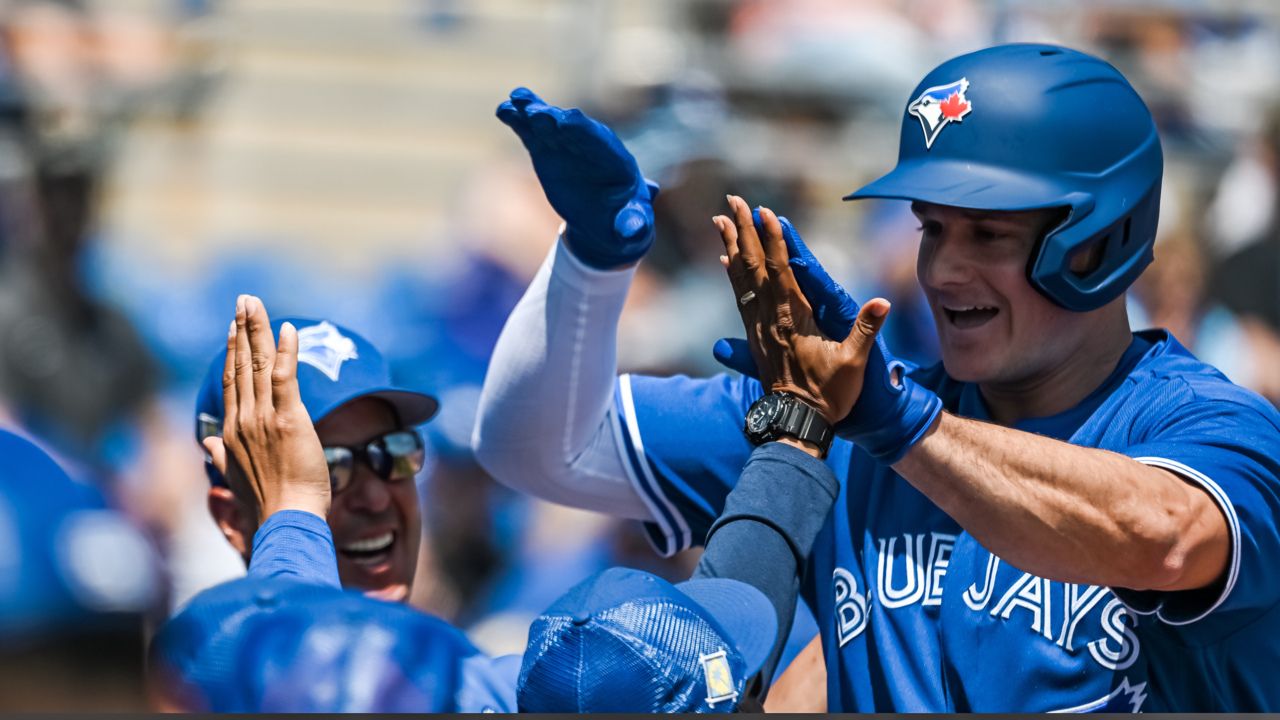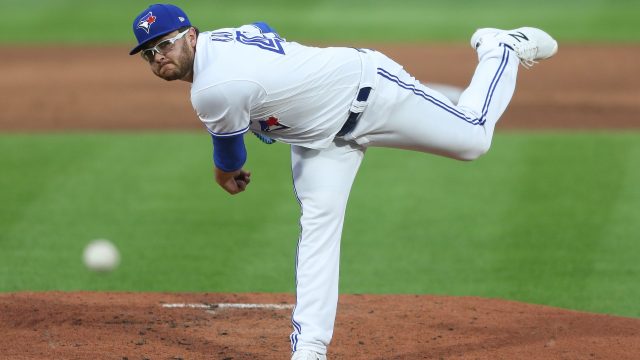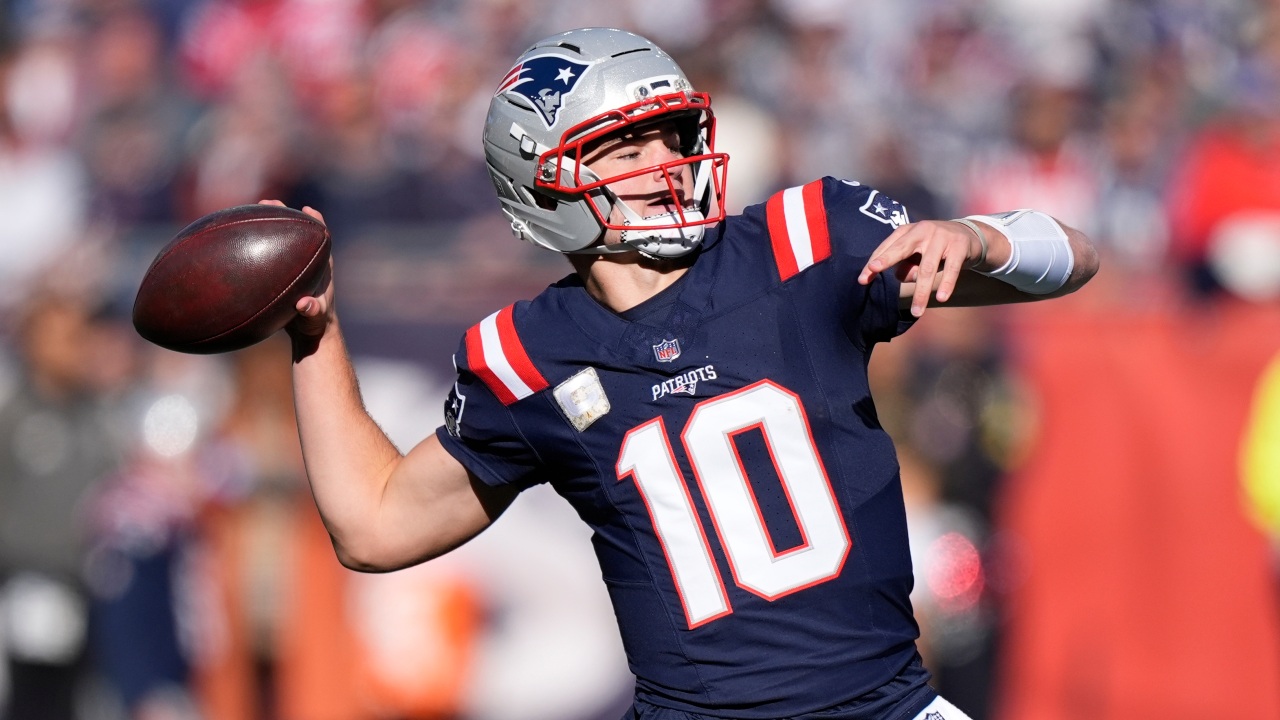
DUNEDIN, Fla. — When he walks to the plate during the regular season, Matt Chapman wants to know two things about the pitcher he’s going to face — what pitch am I looking for and what pitch is he going to try to get me out with. The plan is to swing at the former and lay off the latter.
Easier said than done at baseball’s highest level against the nastiest arms on the planet. But that’s why pre-game preparation is so important in the modern game. Hitters have access to troves of data and video they can use to discern a pitcher’s tendencies, his habits, his cues. Chapman has the resources to formulate his plan to an extreme level of detail. If he wants, he can start the process the night before on his phone.
But what does a guy like Chapman do ahead of his first spring training game on his fourth day with the second team of his career, as he prepares to face some nondescript Pittsburgh Pirates right-hander with only 31 big-league appearances?
“The scouting report was a little more generic,” Chapman says. “Like, ‘Hey, this is what this guy throws. Here are some of his tendencies.’”
That’s where in-game information enters the equation. After another nondescript Pirates pitcher — left-hander Dillon Peters — snuck a first-pitch fastball by him in his first plate appearance of the day, Chapman came back up for his second ready to see the same thing from Bryse Wilson. And here’s the 111.3-m.p.h., 376-foot result:
“My first at bat, I wanted to take a pitch, get comfortable seeing the ball a little bit,” Chapman says. “But then that second at-bat, I was like, ‘OK, I took that first pitch in my first at-bat. If he puts a ball in a good spot, I want to jump on it.’ If I haven’t seen a guy before, I want to wait and see what he’s got a little bit. But if I’ve seen him before and I feel comfortable, then you don’t want to let a good one go.”
That’s the advanced approach and feel for hitting Chapman comes pre-loaded with after the Blue Jays acquired him from the Oakland Athletics last week. He’s best known for his defence, of course, which should help not only make Bo Bichette’s life easier on the left side of the Blue Jays infield, but also shave points off the ERA’s of every pitcher on Toronto’s staff. But Chapman’s patient, disciplined presence in a deep Blue Jays lineup could have a profound impact on the hitters surrounding him, as well.
“I’ve always had a good eye. It’s something that, coming up in the minor leagues, I learned a lot about. Just really being picky with what pitch you want to swing at. Always be aggressive but really be committed to where you’re looking for the ball,” he says. “I really try to zone up in a certain spot. Like, hey, if I’m looking for a ball here, if it’s not in my zone, I’m trying to lay off.”
To wit — Chapman led MLB with 4.29 pitches per plate appearance last season. He swung at only 44.6 per cent of the pitches he saw, the league’s 26th-lowest mark. And that selectivity often got him into advantageous positions. Chapman saw a 3-1 count in 11.6 per cent of his plate appearances, MLB’s 23rd highest rate. That’s a pretty good way to get some fastballs to hit. And wouldn’t you know it, Chapman ended up seeing the highest fastball rate — 56.5 per cent — of his career.
The problem — throughout a difficult, 101-wRC+ season that paled in comparison to the higher standard of production he set earlier in his career — was Chapman couldn’t connect with those heaters. He hit just .208 against fastballs in 2021 following marks of .292, .229, and .255 the three years prior. His slugging percentage against the pitch plummeted in turn, from .833 in 2020 to .486 in in 2021. That’ll happen when your strikeout rate soars from the low-to-mid 20’s in 2018 and ’19 to the low-to-mid 30’s in 2020 and ’21.
You can do this with a plethora of Chapman’s numbers last year, mind you. Both his line drive (14.6 per cent) and hard-hit (30.1) rates were career lows; same goes for his contact rate on pitches both inside (72.4) and outside (52.4) the zone. Something was clearly amiss. And only Chapman knows exactly what that something was.
It’s fair to speculate about the 28-year-old’s right hip, which he underwent surgery on following the 2020 season to repair a torn labrum. Chapman had only five months between that major procedure and his return to everyday competition, leaving plenty of possibility he wasn’t yet completely recovered. If nothing else, Chapman’s preparation for the season would have been severely impacted by his rehabilitation protocol. And when you aren’t feeling your best at the plate, it’s easy to get away from your plan.
Chapman felt that happening in 2021. It started in spring training. He was going into games merely looking to see pitches and react to them with his swing, rather than focusing on what he was trying to attack — and, perhaps more importantly, what he was trying to lay off of. This year, wearing a new uniform in a new camp on the other on the other side of the continent, he wants to make his Grapefruit League plate appearances count.
“That’s something that I really want to hone in on,” he says. “Last year, not feeling like myself, I didn’t go up there committed to what I wanted to do. And this year I really want to commit to locking in on a pitch or an approach and being able to walk into that box and fully, confidently know this is what I want to do. I’m trying to practice that as much as I can in spring.”
So, sure, the power Chapman flashed with his third-inning homer will be a big part of what he brings to the Blue Jays lineup this season. But so, too, will the use of information gleaned from his first-inning flyout, which helped the homer happen. As will the selectivity he displayed in his third and final plate appearance, when he worked a comfortable four-pitch walk. That’s about as solid a start to spring as anyone could’ve asked.

Of course, if you’re in the market for positive indications Chapman could rediscover his earlier career form at the plate, they’re everywhere. Despite his 2021 struggles, Chapman still finished with an 86th percentile barrel rate and 89th percentile maximum exit velocity. His 12.9 per cent walk rate ranked No. 14 across MLB. And his second-half numbers (.043 home runs per plate appearance; 17.1 per cent barrel rate) were far stronger than his first-half ones (.030 home runs per plate appearance; 11 per cent barrel rate).
You can’t fake your way to peripheral stats like those. Either you hit the ball hard as hell with consistency or you don’t. And the more traditional statistics that tend to follow players who consistently hit the ball hard as hell are known as doubles, triples, and home runs.
And walks. That part of Chapman’s game never left. Only 13 players walked at a higher clip than him across MLB last season. He goes to the plate with a plan. With a pitch in mind he’d like to get to and another he doesn’t want to get out on. And he’s stubbornly set on seeing it through.
Pre-game preparation has a lot to do with it. That’s why Chapman will spend a great deal of time in the coming days and weeks learning how the Blue Jays prepare their scouting reports and categorize their charts and videos. It’s an entirely different system than he was used to in Oakland.
But information’s everything in the modern game. And Chapman has a very specific idea of not only the intel he’s after, but how he’d like to utilize it in the batter’s box. It’s an approach that could have an exponential impact on the rest of Toronto’s lineup, not only giving the hitters behind him a better look at the stuff they’ll soon be seeing, but also diminishing the quality of that stuff by forcing the pitcher to endure a fatiguing battle.
And every once and a while, like on a bright Sunday afternoon in Dunedin, he might just leave that pitcher rattled after sending the first pitch of his plate appearance screaming into the left field seats.
“The more at-bats I’ve had in the big leagues, I’ve been able to be more comfortable and more confident. Whenever I can slow the game down, I feel like I really see the ball well,” Chapman says. “I don’t want to make any easy outs or give away at-bats — especially with our lineup. We’re really deep. If we can all continue to grind out at-bats and pick-and-choose our spots when to jump on guys and when to work guys, this lineup is going to give pitchers a hard time.”






